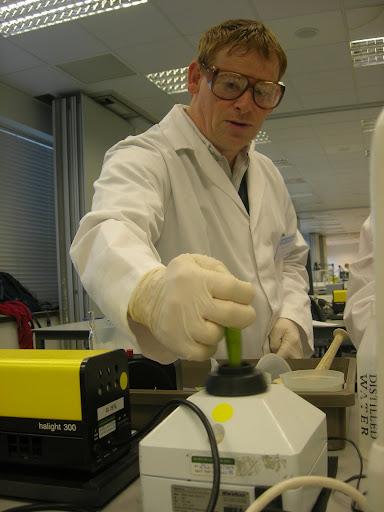This is the 2nd book of the S377 course.
We start to get into a lot of the cellular stuff here. The chapter numbers follow on from the first book - so it starts with Chapter 7.
Chapter 7 - Introducing the Dynamic Cell is quite brief, and is an introduction to the cell and its contents. Nothing particularly new here, but it sets the scene.
Chapter 8 - The Cell Cycle is much more in depth. We cover the mechanisms of mitosis, the cell cycle meiosis and cell division. However this is in quite gory detail. I'm sure many people have seen videos of chromosomes lining up and then separating to opposite ends of the cell. All very nice, I've even seen it under the microscope, although of cells caught in the act rather than dynamic. However you have to ask here, how do the chromosomes move around, how do they pair up, how do they line up? What causes them to separate and how does the cell arrange for it to happen without error.
Chapter 9 - DNA Replication and Repair - again something I've covered many times before. However not in this detail. The typical animated image shows DNA unzipping and getting copied just like that. However its a lot more complicated than that. For instance as the strands separate under the influence of a enzyme, the twisted nature of DNA means that further up the molecule it starts to get all twisted and under tension . Its like unwinding the strands of string, as you pull them apart if starts to ravel up further down. DNA is also often packed up into compact structures, which have to be unpacked before you can even start the replication. Then there is the problem of replicating the lagging strand, the fact that to replicate something like human DNA in any reasonable time you have to have lots of replication at the same time doing different bits, that then all have to get joined together. Yes - its complicated. Then there is repair...
Chapter 10 - Gene Expression - this chapter is all about how genes are switched on and off. Lots of stuff on operon, enhancers, silencers and so on. The infamous Trp operon is considered.
Chapter 11 - Translation and Protein Turnover - the last chapter of this book. Considers how the ribosomes work, how they match the tRNA to the mRNA, and how the tRNA gets the right amino acid attached to itself - again something normally skated over. There is also alternate splicing, mRNA regulation, post transcription modification, nuclear export - lots of details here.
Some fascinating stuff here - and some stuff that is not too well understood.
skip to main |
skip to sidebar

Life studying for a 2nd time around with the Open University and others.
My Latest Blip
About Me
Topics
- A251 (7)
- astronomy (1)
- CMA (4)
- coursera (8)
- courses (40)
- degree (1)
- ECA (2)
- exam (7)
- experiment (3)
- G+C (7)
- html (1)
- intro (1)
- java (1)
- quantum mechanics (1)
- residential (43)
- S103 (19)
- S170 (1)
- S171 (1)
- S193 (1)
- S194 (4)
- S196 (1)
- S204 (21)
- s205 (18)
- S282 (17)
- s283 (8)
- S320 (12)
- S366 (11)
- S377 (10)
- SD329 (9)
- sk195 (2)
- sxr103 (3)
- SXR208 (9)
- sxr270 (7)
- sxr270tutor (7)
- SXR375 (9)
- SXR376 (8)
- TMA (49)
- tutorial (4)
- udemy (3)




No comments:
Post a Comment